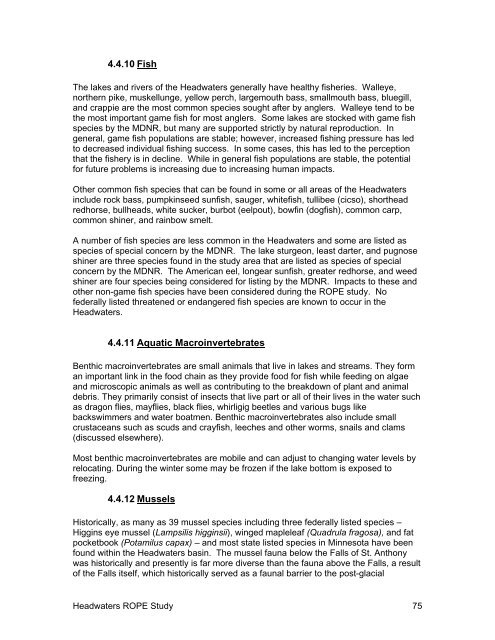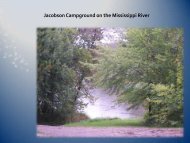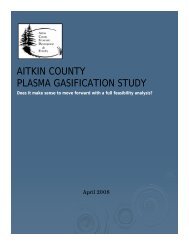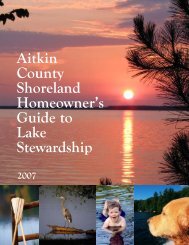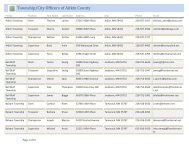4.4.10 FishThe lakes and rivers of the Headwaters generally have healthy fisheries. Walleye,northern pike, muskellunge, yellow perch, largemouth bass, smallmouth bass, bluegill,and crappie are the most common species sought after by anglers. Walleye tend to bethe most important game fish for most anglers. Some lakes are stocked with game fishspecies by the MDNR, but many are supported strictly by natural reproduction. Ingeneral, game fish populations are stable; however, increased fishing pressure has ledto decreased individual fishing success. In some cases, this has led to the perceptionthat the fishery is in decline. While in general fish populations are stable, the potentialfor future problems is increasing due to increasing human impacts.Other common fish species that can be found in some or all areas of the Headwatersinclude rock bass, pumpkinseed sunfish, sauger, whitefish, tullibee (cicso), shortheadredhorse, bullheads, white sucker, burbot (eelpout), bowfin (dogfish), common carp,common shiner, and rainbow smelt.A number of fish species are less common in the Headwaters and some are listed asspecies of special concern by the MDNR. The lake sturgeon, least darter, and pugnoseshiner are three species found in the study area that are listed as species of specialconcern by the MDNR. The American eel, longear sunfish, greater redhorse, and weedshiner are four species being considered for listing by the MDNR. Impacts to these andother non-game fish species have been considered during the ROPE study. Nofederally listed threatened or endangered fish species are known to occur in theHeadwaters.4.4.11 Aquatic MacroinvertebratesBenthic macroinvertebrates are small animals that live in lakes and streams. They forman important link in the food chain as they provide food for fish while feeding on algaeand microscopic animals as well as contributing to the breakdown of plant and animaldebris. They primarily consist of insects that live part or all of their lives in the water suchas dragon flies, mayflies, black flies, whirligig beetles and various bugs likebackswimmers and water boatmen. Benthic macroinvertebrates also include smallcrustaceans such as scuds and crayfish, leeches and other worms, snails and clams(discussed elsewhere).Most benthic macroinvertebrates are mobile and can adjust to changing water levels byrelocating. During the winter some may be frozen if the lake bottom is exposed tofreezing.4.4.12 MusselsHistorically, as many as 39 mussel species including three federally listed species –Higgins eye mussel (Lampsilis higginsii), winged mapleleaf (Quadrula fragosa), and fatpocketbook (Potamilus capax) – and most state listed species in Minnesota have beenfound within the Headwaters basin. The mussel fauna below the Falls of St. Anthonywas historically and presently is far more diverse than the fauna above the Falls, a resultof the Falls itself, which historically served as a faunal barrier to the post-glacialHeadwaters ROPE Study 75
upstream migration of mussels. Nineteen of the 39 species either occurred historicallyor are present below the Falls of St. Anthony and exclusive to Pools 1 and 2 includingseveral Minnesota state listed species and the three federally endangered species. Nopopulations of the three federally listed endangered species currently exist in theMississippi River Headwaters study basin.Presently, 21 live species occur in Pools 1 and 2. Individuals from seven of these 15historical species occurring below the Falls have been relocated from lower MississippiRiver pools during 2000-01 to areas in Pool 2, including 371 of the federally-listedendangered L. higginsii. The mussel fauna within Pools 1 and 2 is dominated (indescending order) by three-horned wartyback (Obliquaria reflexa), threeridge (Amblemaplicata), deertoe (Truncilla truncata), and mapleleaf (Quadrula quadrula). At least fivestate listed species are present, including two listed as endangered in Minnesota, rockpocketbook (Arcidens confragosus) and wartyback (Quadrula nodulata). Quadrulanodulata ranked fourth in abundance in Pools 1 and 2, and nowhere in the UpperMidwest has the species been reported in such high numbers.It appears that mussels are expanding their range above St. Anthony Falls, now easilycircumnavigated by mussels’ obligatory host fish through the navigation locks. TheMississippi River St. Anthony Falls Pool (St. Anthony Falls to the Coon Rapids Dam)harbors 17 live species including 11 species previously not reported. Apparently, thesespecies have arrived as larvae attached to fish that have used navigation locks to travelaround the Falls of St. Anthony. The community is dominated by deertoe with threeother species also abundant: mapleleaf, plain pocketbook (L. cardium), and pinkheelsplitter (Potamilus alatus). Two Minnesota state listed species also occur: blacksandshell (Ligumia recta) (special concern) and round pigtoe (Pleurobema sintoxia)(threatened).It appears at present that the Coon Rapids Dam serves as a faunal barrier to upstreamdispersal from the lower Mississippi River, much as the Falls of St. Anthony has donehistorically. The entire Mississippi River proper above the Coon Rapids Dam harborsonly 11 live species and, cumulatively, the Mississippi River tributaries above the CoonRapids Dam harbor the same 11 species plus an additional one, threeridge (Amblemaplicata). In addition to being less species rich, mussel community composition andspecies’ relative abundance vary as well, as compared to the lower river. Generally, inriverine portions of these upper reaches of the Mississippi River and its tributaries,communities tend to be dominated by fatmucket (Lampsilis siliquoidea) and plainpocketbook, whereas in lakes and reservoirs, giant floater (Pyganodon grandis), aspecies more adapted to softer substrate and lentic conditions, tends to be dominant.Not surprisingly, two species present in these upper reaches and not found in theMississippi River proper below the Coon Rapids Dam, creek heelsplitter (Lasmigonacompressa) and paper pondshell (Anodontoides ferussacianus), are more typical ofheadwaters and smaller streams. Creek heelsplitter is generally found throughout theseupper reaches, and although found in the Mississippi River proper, they tend to be morecommon in the smaller tributary streams. Cylindrical papershell (Anodontoidesferussacianus) typically occurs in small order tributary streams and the extremeHeadwaters of the Mississippi River. Two state listed species present are the blacksandshell and creek heelsplitter. Black sandshell populations appear healthy in manyareas of the riverine portions of the Mississippi River.Headwaters ROPE Study 76


